
3d modeling the hulk
Drawing and Clay IInitial Sketches
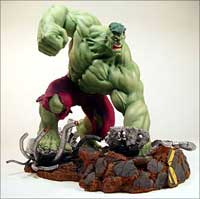
“In the drawing stage,” says Jesus, “we basically establish the pose. We want to capture a key moment.”
In this case, the firm settled on a classic stance: the Hulk smash. “The Hulk smash shows him in the aftermath of one of his attacks,” says Jesus. “It has pavement buckling and something already destroyed. But it’s a subtle pose too. It shows massive bulk but has a more delicate gesture.”
The Armature
Once the drawings are done and the pose established, it’s time to begin sculpting. Stone begins by building an armature, or skeleton for the piece. To do this, she uses aluminum and steel wire, and experiments with various combinations to make sure the statuette is able to stand-up on its own.
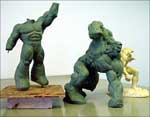
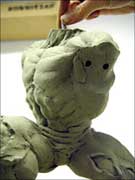
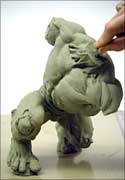
With a figure the size and shape of the Hulk, the main concern is that the skeleton is sturdy enough. “The Hulk is a big piece,” says Jesus. “You have to give it a strong back and hips. Remember, it’s going to go through a clay stage and a wax stage, so you have to make it really strong.”
Blocking Out The Major Forms
Drawing and Clay III
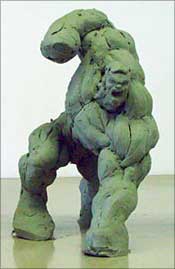 In the next phase, Stone creates rough versions of the major body parts, making sure they’re all in proportion to one another.
In the next phase, Stone creates rough versions of the major body parts, making sure they’re all in proportion to one another.
“At this point, you’re building the major relationships,” says Jesus. “You need to establish the head versus the shoulders versus the hips.”
To hear Jesus say it, creating a head that fits right on the shoulders and doesn’t look odd next to the arms involves a lot of trial and error. The moment the sculptor adjusts the thigh so it looks right next to the hips, he or she discovers that those two pieces are now out of proportion with the shoulders and the head. Then, more clay has to go on or come off.
One way to speed up the process is to always work on the statue as a whole. “In painting class, they teach you to address everything in your painting in one sitting,” says Jesus. “The same thing is true with sculpture. You want to address every problem you have every time you work on it.”
Using Photo References
Drawing and Clay IV
Once the Hulk’s major body parts were properly blocked out, it was time to start refining his features. At this point, the problem is one of realism—Stone needs to make sure the statuette looks human, or at least as human as the Hulk. And so, she begins working with a number of different photographs either of people who look like him or are in a similar pose.
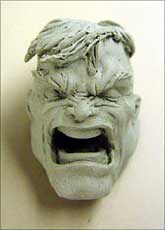
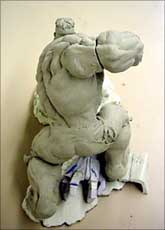
“When you sculpt,” says Jesus, “you can make it up, but it’s not advisable. We shoot photos to save time and make it more solid.”
Of course, since no one completely resembles the Hulk, the photo references had to come from different sources, with each one showing a part of the whole. For example, the musculature came from bodybuilders, while the face was based on a picture of Jesus himself (Manuel, we mean).
Clay model casting
Initial Sketches
By the time the clay modeling was done, the Hulk looked pretty good from a distance. “When things get refined to a stage, where, if you squint your eyes, it looks done, then we submit it to clay approval,” says Jesus.
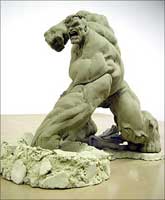
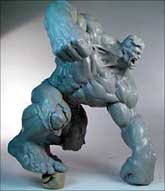
At that point, the clay model is ready to go through a series of processes that will transform it into a wax statue. First, it’s placed in a box and propped-up with tiny foam cores. Next a pancake-like batter of silicone is poured in over it.
But along with the wax also comes a problem: air bubbles. If they aren’t removed, they can corrupt the surface of the wax statue. To avoid this, the Asylum uses a huge, kettle-like pressure pot, which uses an air compressor to squeeze the silicone and eliminate any of the bubbles.
At that point, the Hulk clay statue is encased in a solid, square block of silicone. The block is then cut into three pieces, and the clay statue is broken out, making a form. Finally, they pour the wax into the clay form and Stone has a new version of the Hulk with which to work.
Sculpting Wax
The Wax Stage II
Now comes the painstaking job of refinining the wax statue to its final form. Most of the work is done with a wand-like tool called a digital waxer. Similar to a soldering iron, it heats and applies wax at 300 degrees.
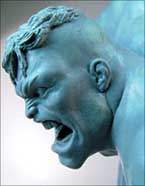
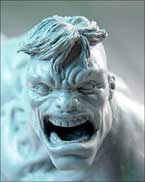
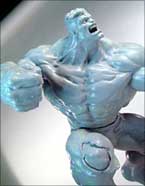
“Wax sculpting is an additive and subtractive process,” says Jesus. Some places on the Hulk needed to be carved away, and others needed wax to be piled on and then refined. The most careful work centers around the face, where Stone has to etch out teeth and eyes. Another place of concern is the Hulk’s immense musculature, which must be enhanced and then buffed down to remove imperfections.
Remolding
The Wax Stage III
After a lot of work, and careful inspection by the client, the wax model is done. “One thing people don’t realize is that the size difference between clay and the final product can be as much as 10%. Each time you mold it, it gets smaller,” says Jesus.
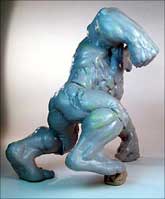
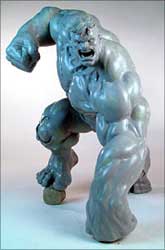
At this point, two important steps remained. The first is to make a steel casting that can replicate the model thousands of times in a factory. And the second, and most important part, is the painting.
Cartoon Paint
Painting I
Jesus himself has painted hundreds of models and knows it’s painstaking work. Most times, as with the Hulk, the work has to be done entirely by hand. However, for things like spaceships, superhero chest emblems, and embroidery, the company uses Adobe Illustrator to make patterns that will be silk screened onto the figures.
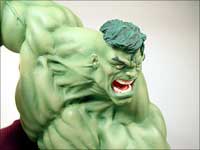
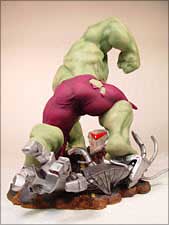
The first problem in painting, of course, is to find the right paint. And for this, the Asylum turns to an odd source: the cell animation industry.
“Cell animation paint has a great deal of elasticity, and it’s really a matte paint,” says Jesus. “Cartoon color paints are what they say. And the chromo is intense. In animation they work with three or four layers of acetate, so you have to really control the color with them.”
Design Decisions
Painting II
The painters also had one important color decision to make for the Hulk. In his comic book and movie incarnations, the character has an almost surreal green hue, which wouldn’t work for a statuette. Instead, the Asylum decided to make the statue’s flesh tone a little more realistic.
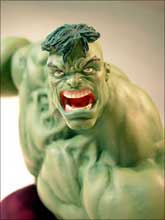
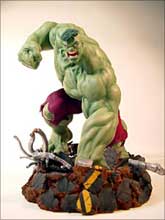
“We tend to do that for Marvel,” says Jesus. “We take a comic book look and give it a more realistic spin.”
In the actual painting, particular detail was again accorded to the eyes and face. There, the painter worked from photos and spent an enormous amount of time making sure everything was perfectly realistic.
Hulk Smash!
Conclusion
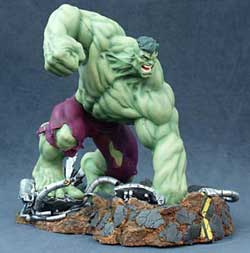 In the end, the figures and castings are shipped off to Hong Kong. There, the company’s factory stamps out the pieces, paints them according to the models, and ships them around the world. The final Hulk statuette stands about twelve inches tall and is available in a limited edition for collectors. But given the Hulk’s fan base, and the popularity of the film, it’s hard to see that it won’t—like many an Art Asylum toy—sell out
In the end, the figures and castings are shipped off to Hong Kong. There, the company’s factory stamps out the pieces, paints them according to the models, and ships them around the world. The final Hulk statuette stands about twelve inches tall and is available in a limited edition for collectors. But given the Hulk’s fan base, and the popularity of the film, it’s hard to see that it won’t—like many an Art Asylum toy—sell outquickly.




